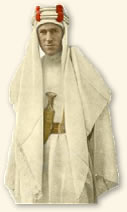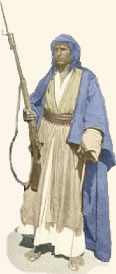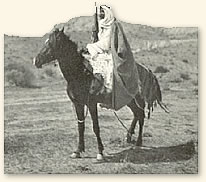|
Lawrence of Arabia, 1918
Before 1914, twenty-six-year-old T.E. Lawrence worked
for the British Museum digging among the Hittite ruins in Mesopotamia. The Oxford
graduate had spent years in the desert developing an intimate knowledge and love
of the Bedouin tribes that roamed the region. At the outbreak of war  Lawrence
was rejected as physically unfit for military service but his unique knowledge
of the area made him a perfect candidate for the Intelligence Service at Cairo. Lawrence
was rejected as physically unfit for military service but his unique knowledge
of the area made him a perfect candidate for the Intelligence Service at Cairo.
The war in the Middle East did not go well for the British in the early days of the conflict. Their defeat at Gallipoli and inability to dislodge the Turks from the Dardanelles exposed the Suez Canal to potential attack. Meanwhile, the Arabs viewed the involvement of the Ottoman Empire in World War One as an opportunity to revolt and drive the Turks from their land. Seizing this chance to harass the Turks, the British lent support to the Arabs through shipments of arms and money. The revolt sputtered however and was by 1916 in danger of collapsing. Lawrence was sent to bring order and direction to the Arab cause. The experience transformed the introverted and studious Lawrence into one of the most colorful military figures of the war. For two years Lawrence and his band of Arab irregulars attacked Turkish strongholds, severed communications, destroyed railways and supported the British regular army in the drive north to Damascus.
In the following account Lawrence describes one of the most controversial episodes of his experience in the Desert. On September 27, 1918 he and his Arab force were in hot pursuit of a retreating Turkish column numbering approximately 2,000 soldiers. Coming upon the village of Tafas south of the city of Damascus they were confronted with the horrifying aftermath of the Turk rampage through the village. Mutilated bodies of women and children lay among the smoking ruins. As the sickened Lawrence watched the scattered Turkish column disappear over the horizon he gave his order: "take no prisoners."
"The village lay stilly under its slow wreaths of
white smoke, as we rode near, on our guard. Some grey heaps seemed to hide in
the long grass, embracing the ground in the close way of corpses. We looked away
from these, knowing they were dead; but from one a little figure tottered off,
as if to escape us. It was a child, three or four years old, whose dirty smock
was stained red over one shoulder and side, with blood from a large half-fibrous
wound, perhaps a lance thrust, just where neck and body joined.
The child ran a few steps, then stood and cried to us in a tone of astonishing strength (all else being very silent), 'Don't hit me, Baba.' Abd el Aziz, choking out something - this was his village, and she might be of his family - flung himself off his camel, and stumbled, kneeling, in the grass beside the child. His suddenness frightened her, for she threw up her arms and tried to scream; but, instead, dropped in a little heap, while the blood rushed out again over her clothes; then, I think, she died.
 |
| A Bedouin warrior |
We rode past the other bodies of men and women and four more dead babies, looking very soiled in the daylight, towards the village; whose loneliness we now knew meant death and horror. By the outskirts were low mud walls, sheepfolds, and on one something red and white. I looked close and saw the body of a woman folded across it, bottom upwards, nailed there by a saw bayonet whose haft stuck hideously into the air from between her naked legs. About her lay others, perhaps twenty in all, variously killed.
The Zaagi burst into wild peals of laughter, the more desolate for the warm sunshine and clear air of this upland afternoon. I said, 'The best of you bring me the most Turkish dead,' and we turned after the fading enemy, on our way shooting down those who had fallen out by the roadside and came imploring our pity. One wounded Turk, half naked, not able to stand, sat and wept to us. Abdulla turned away his camel's head, but the Zaagi, with curses, crossed his track and whipped three bullets from his automatic through the man's bare chest. The blood came out with his heart beats, throb, throb, throb, slower and slower.
Tallal had seen what we had seen. He gave one moan like a hurt animal; then rode to the upper ground and sat there a while on his mare, shivering and looking fixedly after the Turks. I moved near to speak to him, but Auda caught my rein and stayed me. Very slowly Tallal drew his headcloth about his face; and then he seemed suddenly to take hold of himself, for he dashed his stirrups into the mare's flanks and galloped headlong, bending low and swaying in the saddle, right at the main body of the enemy.
It was a long ride down a gentle slope and across a hollow. We sat there like stone while he rushed forward, the drumming of his hoofs unnaturally loud in our ears, for we had stopped shooting, and the Turks had stopped. Both armies waited for him; and he rocked on in the
 |
| Talall El-Hareidhin of Tafa |
hushed evening till only a few lengths from the enemy. Then he sat up in the saddle and cried his war cry, 'Tallal, Tallal,' twice in a tremendous shout. Instantly their rifles and machine-guns crashed out, and he and his mare riddled through and through with bullets, fell dead among the lance points.
Auda looked very cold and grim. 'God give him mercy; we will take his price.' He shook his rein and moved slowly after the enemy. We called up the peasants, now drunk with fear and blood, and sent them from this side and that against the retreating column. The old lion of battle waked in Auda's heart, and made him again our natural, inevitable leader. By a skilful turn he drove the Turks into bad ground and split their formation into three parts.
The third part, the smallest, was mostly made up of German and Austrian machine-gunners grouped round three motor cars and a handful of mounted officers or troopers. They fought magnificently and repulsed us time and again despite our hardiness. The Arabs were fighting like devils, the sweat blurring their eyes, dust parching their throats; while the flame of cruelty and revenge which was burning in their bodies so twisted them that their hands could hardly shoot. By my order we took no prisoners, for the only time in our war.'"
References:
Lawrence, T.E., Revolt in the Desert (1927); Lawrence, T.E., Seven Pillars of Wisdom (1926); Thomas, Lowell, With Lawrence in Arabia (1924).
How To Cite This Article:
"Lawrence of Arabia, 1918 - Attack on a Turkish Column," EyeWitness to History, www.eyewitnesstohistory.com (2000).
|






